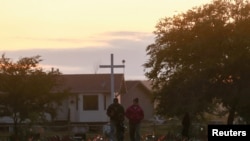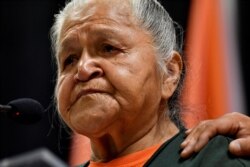Weeks after the discovery of more than 1,000 probable unmarked graves at now-closed schools for indigenous people, leaders of Canada's First Nations are torn over whether to press for further forensic investigation and the repatriation of remains, or to let the sites be preserved undisturbed.
Indigenous communities have had two months to absorb the shock since the discovery of what appear to be hundreds of unmarked student graves near the former Kamloops Indian Residential School was announced in May.
Scientists used ground penetrating radar to explore the site on the Tk'emlups te Secwépemc First Nation's traditional territory in the western province of British Columbia, where the closed school building still sits. They found 200 anomalies that remain "targets of interest" and probable burials under a present day apple orchard.
Using similar detection methods, hundreds of other probable unmarked graves of students have since been found on property of other closed residential schools across Canada, bringing the total to about 1,300.
Indigenous residential schools were paid by the Canadian government and run by various Christian churches starting in 1828. The last one closed in 1996.
For most of their existence, Native children were taken by force from their families and placed into these institutions to be assimilated into Western culture. Reports abound that sexual, physical and verbal abuse were common.
A suspected grave site cannot be confirmed until it is excavated, and some First Nation leaders are demanding a thorough investigation of the sites and an effort to repatriate the remains.
Tk'emlups te Secwépemc Chief Rosanne Casimir is calling the site in Kamloops a crime scene and says what happens next has to be done carefully and in consultation with the community and survivors.
"We do know that our membership has been grappling with the information that has been shared. And we do know that every step that we do take moving forward, we're going to be having the community consultation with our membership," she said during a press conference in Kamloops.
But many of the survivors, like Evelyn Camille, want the sites to be left undisturbed.
"Yes, they may have to be some studies to be done," she said at the same press conference. "What good are those studies going to do for us, for an individual, for me? It's good to tell me that yes, they were murdered. Is that going to make me feel better? I don't think so. Those remains should be left undisturbed."
Other Canadians are telling pollsters they are shocked by the revelations and want to see something done to acknowledge the mistreatment of indigenous children. A survey by Toronto-based Ipsos Public Affairs found that 77 percent of the public thinks there should be a national day of remembrance for the victims.
"It's about people who were truly victims, in this instance, and Canadians do have a lot of sympathy for what happened here," Ipsos Public Affairs CEO Darrell Bricker told VOA. "They're feeling badly about it, they want to see something done about it."
The Kamloops Indian Residential School was one of the largest of the 139 that existed across Canada.
It is expected that many more potential unmarked graves around other schools are yet to be discovered.










